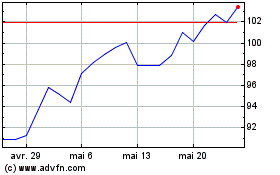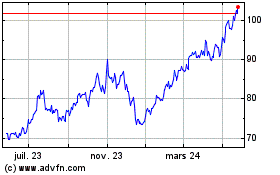UPDATE: Japan Quake, Tsunami Caused Up To $25Bln Insured Loss - Eqecat
16 Mars 2011 - 6:42PM
Dow Jones News
Disaster-modeling company Eqecat on Wednesday said insured
losses from Japan's earthquake and tsunami would be $12 billion to
$25 billion, an estimate whose high end is significantly lower than
an earlier prediction.
Eqecat said a portion of the costs in its estimate--$2 billion
to $4 billion--would be borne by the government's Japan Earthquake
Reinsurance Pool, which will reduce the total cost to private
insurers.
The massive earthquake, upgraded by seismologists this week to a
magnitude 9.0, toppled buildings and triggered a tsunami that swept
away cars, buildings and ships. The estimate from Eqecat includes
insured losses from the quake, the ensuing tsunami and fires, and
losses to cars and ships. Eqecat said it had reports of 90 large
commercial vessels and thousands of smaller vessels getting pushed
far inland by the tsunami.
The estimate also includes an estimated payout of $2 billion to
$3 billion by life insurers.
While the exact cost of the disaster won't be known for months,
estimates from catastrophe-risk modeling companies like Eqecat give
an early glimpse at the ultimate costs. A competing firm, AIR
Worldwide, estimated Sunday the quake caused insured property
losses of $15 billion to $35 billion. Its estimate didn't include
the effects of the tsunami.
While Eqecat's estimate is lower, the disaster could still
become the largest ever earthquake loss for the insurance industry.
The only quakes that rival it are the $15.3 billion earthquake in
Northridge, Calif., in 1995, and last month's temblor in
Christchurch, New Zealand, where insured costs are still being
tallied but could exceed $10 billion.
Industry analysts have been attempting to determine if losses
from the disaster would force the price of catastrophe insurance
higher around the globe. Insurers and reinsurers are already on the
hook for substantial claims tied to storms and flooding in
Australia and the Christchurch quake, and analysts said many
reinsurance companies will report first-quarter losses and may end
up losing money for all of 2011.
The world's largest reinsurers, Swiss Reinsurance Co. (RUKN.VX)
and Munich Re (MUV2.XE), said before last week's catastrophe they
had already largely exhausted their annual provision for natural
disasters.
If the Eqecat estimate proves true, prices may stop their
years-long decline, but some analysts and executives have said
losses would have to be substantially larger to cause prices to
rise.
Ratings firm Standard & Poor's said on Tuesday before the
release of the Eqecat estimate that it didn't expect to make
widespread ratings cuts against insurers "because much of the
industry is dealing with this disaster from a position of capital
strength." The company has downgraded its outlook on Japanese
property insurers to negative from stable.
However large the insured loss, the economic damage of the quake
is sure to be much larger. Earthquake coverage is far from
universal in Japan, and many homes and businesses were uncovered.
Also, the government is ultimately responsible for liability costs
tied to the ongoing nuclear disaster.
Japan's Fire and Disaster Management Agency said Monday the
number of buildings completely or partially destroyed by the
earthquake had reached 75,000. But Eqecat, in a statement, warned
it was "an early tally."
-By Erik Holm, Dow Jones Newswires; 212-416-2892;
erik.holm@dowjones.com
Arch Capital (NASDAQ:ACGL)
Graphique Historique de l'Action
De Juin 2024 à Juil 2024

Arch Capital (NASDAQ:ACGL)
Graphique Historique de l'Action
De Juil 2023 à Juil 2024
